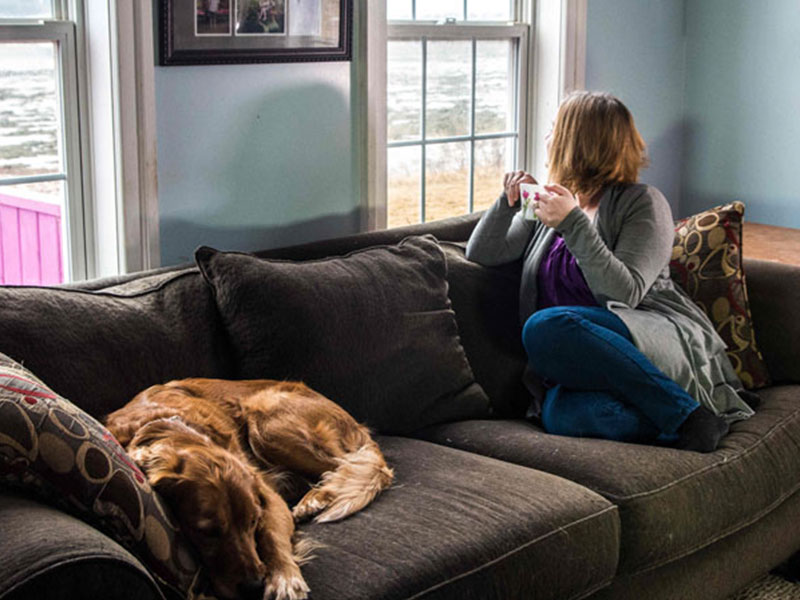The Clean Energy Financing program helps a family on Long Island upgrade their home’s efficiency, feel warmer, and save money – while paying for the retrofits at a pace they can afford.
Sipping tea while looking out the living room window of her 200-year-old house, a loyal and very relaxed golden retriever sharing a corner of the couch, Heidi Tudor takes in a view as expansive as the Atlantic Ocean.
She lives on Long Island in the Bay of Fundy, separated from Digby Neck by the ‘Petit Passage’ and from Brier Island by the ‘Grand Passage.’ The view from her home is one the resource teacher, her husband, and their two adopted daughters never tire of. But sometimes, after getting their heating bills, Heidi felt like they were also heating the great outdoors the family enjoys so much. “We’ve had some enormous power bills,” says Heidi, “and our house was still so cold.”
Like many people, Heidi and her husband wanted to invest in energy efficiency upgrades to make their house warmer – and to save money in the long run. But the large upfront costs of the retrofits were prohibitively high.
Luckily, however, the Municipality of the District of Digby had partnered with Clean Foundation to design and run a unique program that helps homeowners make clean energy and efficiency upgrades to their homes in a way that’s affordable.
Through the Clean Energy Financing program, the District of Digby paid upfront for the Tudors’ retrofits. They will pay back the low-cost financing over ten years through a monthly installment similar to how they pay their tax bills. Using the municipal tax system this way is why these types of initiatives – which are gaining traction across Canada and in the U.S. – are often called Property Assessed Clean Energy (PACE) programs. Clean Foundation, a non-profit environmental organization based in Nova Scotia, manages this version of a PACE project on behalf of the District of Digby. The ‘Clean Energy Financing’ PACE program is active in six other municipalities in Nova Scotia.
“We got involved in Clean Energy Financing to help homeowners upgrade to energy efficiency in their home through things like heat pumps, insulation, windows, and electric thermal storage,” says Terry Thibodeau, Coordinator of Renewable Energy and Climate Change for the Municipality of Digby.
“It’s a way to reduce greenhouse gases and improve efficiency in their home and reduce costs,” he explains, standing at the base of one of two wind turbines the Municipality owns, the slowly spinning blades nearly obscured by the morning fog.
And here’s what makes Clean Energy Financing so appealing – through a careful assessment of your home’s efficiency and then tailored recommendations from an experienced energy advisor, you will save as much or more on energy bills than what you are paying for the retrofits and cost of borrowing.
“The program calls for a 1-to-1 ratio, so that means for every dollar spent, there’s a dollar in savings,” adds Thibodeau. “And what we’ve been finding so far is that the payback on many of these projects will probably be less than the anticipated ten years, maybe only seven years. That means on a ten-year program, after those payback years, it’s disposable income in their pocket and money saved for other purposes in their home.”
It’s like getting free home upgrades to make your house warmer, all the while reducing your carbon footprint. Upgrades can include insulation, energy efficient windows and doors, as well as high efficiency heat pumps, hot water heaters and heat recovery ventilators. A Home Energy Assessment determines what upgrades are the best ‘bang for the buck’ for each individual house.
Another unique feature of Clean Energy Financing is that the loan is attached to the property, not the individual. Even if you were to sell your home, the financing obligation becomes the responsibility of the next homeowner. You aren’t on the hook if you sell the house before you pay off the upgrades, and, while the next homeowner does have to take over the loan, they also enjoy the savings on heating costs.
These smart energy investments pay for themselves, and the pilot program was the winner of the Union of Nova Scotia Municipalities’ 2016 Climate Change Leaders Award. It’s good for the environment, good for the homeowner, and good for the municipality. Clean Foundation runs the program, working with homeowners to find the best solutions for their unique situations – all the while ensuring the upgrades are saving enough money to pay for the retrofits.
“We’ve been in the house for five years,” says Tudor, looking around a house with original beams and stories etched into the walls. “Clean Energy Financing came onboard with insulation in the attic and the basement, and a heat pump in the kitchen.”

“We were able to get the work done without any upfront costs because the municipality initially pays for the work and then we pay it back through our municipal taxes. It will all weigh itself out because our power bills will go down.”
“And for sure it is significantly warmer! My feet are not cold. Rooms that were the coldest in the house are now the warmest.” Her dog opens his eyes but doesn’t move as Heidi gets up to start making a snack for her daughters, who just returned from a long bike ride around the island. “The kitchen is so nice now – it’s where we enjoy hanging out the most.”

Recent Comments